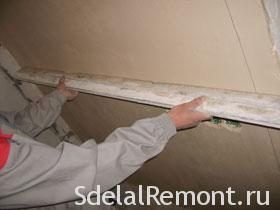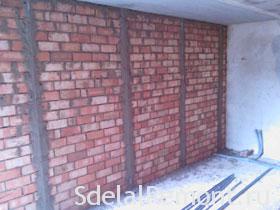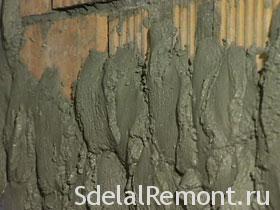Like any classic, good work plasterer is based on the "three pillars" - high-quality surface, composition plaster, and the availability of accurate lighthouses. First vote plaster surface. It must have strength, sufficient to retain the applied plaster. The surface must not flake and crumble. Re-plastering of the old plaster is not recommended, since defects may be lurking in the old plaster, that show up only when dry new plaster. As a result, you will have to remove everything and start over. Site renovated apartment with his hands reveal the secrets of the wall plaster, then you yourself can do it.
Internal plaster the walls with his own hands
If the base surface is conventional bricklaying, allowed to use a mixture of plaster on cement. This is the best option. It turns out cheap and allowed thicker layers overlaying (for brick walls is often necessary). But, layer is applied if more than 20 mm, plaster must be reinforced plaster grid. When done interior plaster walls - brick wall primer is not necessary, If the wall is no oil stains and dust. So plastered conventional building bricks.
If you have to plaster facing brick, the situation is more complicated. Here it is necessary to use a special primer and reinforcement. The technology is quite complicated and it is better to invite to this proven specialists. Due to the smoothness of the surface of facing bricks and Neboli shoy porosity plaster poorly adheres to the surface. As a result, the composition of plaster peeled off pieces (sometimes together with a grid), that fall. Even, if the reinforcement is a quality and plaster does not fall, in a short time on the surface of the plaster will crack.
shoy porosity plaster poorly adheres to the surface. As a result, the composition of plaster peeled off pieces (sometimes together with a grid), that fall. Even, if the reinforcement is a quality and plaster does not fall, in a short time on the surface of the plaster will crack.
For plastering smooth concrete walls need plastering composition of gypsum-based. In this case, the base surface primer obligatory. Best plastering gypsum compositions are those, which contain silica particles (sand), that impart a smooth surface of small roughness, which will ensure sufficient adhesion with the surface of the plaster. plaster reinforced polymeric mesh with a mesh of 5 mm × 5.
Plastering rough concrete are used as cement, and gypsum formulations. Grungy concrete must also be primed, but it is possible to use a primer without quartz particles. Suitable primers offer "miners" and "GLIMS".
For plaster foam concrete surfaces is better to use gypsum compositions, but allowed and cement. But the primer is absolutely necessary, not easy, and the so-called "deep penetration».
Pazogrebnevye gypsum blocks, from which to make the partition, best plastered plaster compositions with conventional pretreatment primer.
After assessment and selecting a base surface and a plaster composition must exhibit beacons.
Installation of beacons on the wall for plaster
 Lighthouses in construction - guides, which help to align the surface with a liquid formulation. Plaster beacons perforated profiles are used in the form of rolled tavrovogo. The width of the profile depends on the thickness of the applied plaster. Special beacons are good, that they should not be removed after the plastering work - they remain in the thick plaster. So then it is not necessary to close up after removal of deepening lighthouses.
Lighthouses in construction - guides, which help to align the surface with a liquid formulation. Plaster beacons perforated profiles are used in the form of rolled tavrovogo. The width of the profile depends on the thickness of the applied plaster. Special beacons are good, that they should not be removed after the plastering work - they remain in the thick plaster. So then it is not necessary to close up after removal of deepening lighthouses.
nomination and installation of beacons on the wall to plaster, in need of special care. First, check the entire room, to determine its geometry deviation from the correct form. This is done by gon, plummet, rack level, long rule (at least two meters) and roulette.
Gon check the correctness of the angles between the walls. Vertical wall is checked by a plumb. Flatness is tested rule. Rack level check biases horizontal surfaces and is used as an auxiliary tool for checking slope walls. roulette is needed, to accurately measure deviations, some other tools. Also can be measured with a tape measure diagonally premises - if the diagonals are not equal, the room is not rectangular, and angles it does not direct. Upon completion of all measurements is decided on exhibiting lighthouses. This may be a change in shape of the room to give the correct geometric or simple leveling uneven walls - it all depends on the tasks, persecuted plastering.
Before installing beacons walls fully primed. exhibited beacons for fast curing solution or to the, which will be plastered. Wall applied vertical strip solution, into which the beacons. Before hardening solution beacons need to have time to equalize the levels and heights. The distance between the beacons is installed, used to rule rested at their ends to two adjacent lighthouse and has been able to move slightly on them, not slipping from them. Find out the number of bags of plaster and consumption will help building online calculator materials.
How to apply the plaster on the wall, application technology
 plastering technology is quite simple. Between adjacent beacons wall trowel snaps excess amount of solution (this is called "gallop"). After the charges Rule, We are relying on adjacent beacons, solution leveled bottom upwards.
plastering technology is quite simple. Between adjacent beacons wall trowel snaps excess amount of solution (this is called "gallop"). After the charges Rule, We are relying on adjacent beacons, solution leveled bottom upwards.
Professional Plasterer gallop use "falcon". This flat area at the bottom of the handle. Superimposed on the pad in a volume of plaster, much larger, than using a trowel. Holding a falcon in one hand, plastering trowel in the other hand resets solution Falcon wall. This technique provides higher productivity. The technology of plastering the wall not radically, can throw a solution so, at your convenience. here how fast the plaster walls of the hopper bucket.
To make a thicker layer of plaster, first make a rough gallop without leveling on beacons. Once this layer dries and loses mobility, You can do namet finishing and leveling by the method described.
Damage and extended beacons solution is dried and make it a grout, that is plastered surface is polished, to remove small defects. In this process gypsum plastering walls mixtures ends. Now we offer watch video lessons, we have picked up on this matter. Find out the amount of solution for the purchase will help our online calculator.












